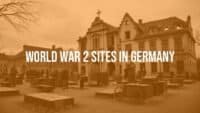Germany sits in the center of Europe and has a deep and difficult connection with its World War 2 history. Rather than ignore or hide these events, Germany has turned many locations into memorials, museums, and centers for learning. These places remind us of the terrible acts that took place under Nazi rule and the worldwide destruction that followed. Visiting them is a chance to face the past, learn from it, and think about the ongoing value of peace and respect for others.
You’ll find everything from the remains of concentration camps and large Nazi meeting grounds to buildings in Berlin damaged by bombing and quiet spots honoring those who fought or were killed. Germany’s World War 2 sites are more than old buildings-they teach us about history in real, powerful ways and help everyone remember and learn, so similar tragedies are less likely to happen in the future.

World War 2 Sites in Germany: Why They Matter Today
Why Keep World War 2 Sites?
Germany puts a lot of effort into keeping World War 2 sites. This comes from a strong wish to face the past, a process called “Vergangenheitsbewältigung” in German. Rather than forget these times, Germany keeps these locations open and explains their stories, so no one forgets what happened. The goal is to honor the victims, admit what people did wrong, and teach everyone-now and in the future-about what led to such suffering.
These sites are real places that connect people to past events in ways that books cannot. Being where these things happened makes the lessons clearer and helps people understand how easy it is to lose peace and freedom. By keeping these memories alive, Germany hopes to stop anyone from changing the story for the worse. It also gives a full look at the past, including everyone’s involvement.
How Do These Memorials Teach Us?
World War 2 memorials in Germany are valuable for learning. Instead of only reading about history, people can visit where it happened. Walking around a camp, standing in places where Nazi speeches were held, or seeing the leftovers of bombed cities makes the history feel real and close. Many museums use personal stories, survivor interviews, and maps to help explain.
Examples include the Documentation Center at the Nuremberg Rally Grounds and the Topography of Terror in Berlin. These places explain how the Nazis came to power, what they believed, and how their actions harmed millions. Many museums and camps also offer classes and guided trips for students, keeping the lessons alive across generations.

Concentration Camps and Holocaust Memorials in Germany
Here are some main memorial sites:
| Name | Location | Brief Facts |
|---|---|---|
| Dachau | Near Munich | First Nazi camp (1933). Over 200,000 people held; at least 41,500 died. |
| Buchenwald | Near Weimar | One of the largest. Held political prisoners, Jews, Roma, and others. Used by Soviets after WW2. |
| Bergen-Belsen | Lower Saxony | Became notorious in the final years; about 52,000 died, including Anne Frank. |
| Neuengamme | Near Hamburg | Largest in northwest Germany. Forced labor camp with many original buildings left. |
| Flossenbürg | Bavaria | Prisoners worked in stone quarries. The memory site was opened in 1995. |

Main World War 2 Sites in Berlin
- Reichstag building: The parliament still shows minor damage from the 1945 battle for Berlin. The building was central to Hitler’s rise and fall.
- Topography of Terror: Site of the former Gestapo and SS headquarters. Now an open-air and indoor museum focused on Nazi crimes.
- Holocaust Memorial (Memorial to the Murdered Jews of Europe): A striking field of grey concrete slabs symbolizing the loss experienced during the Holocaust. An underground center provides detailed stories.
- German-Russian Museum Berlin-Karlshorst: The location of Germany’s surrender to the Allies in 1945. Focuses on the Eastern Front.
- Fuhrerbunker remains: Site of Hitler’s last days is now a parking lot with a simple sign to avoid glorification.
- Sachsenhausen Concentration Camp (just north of Berlin): A model for later Nazi camps; used by the Soviets after the war as a prison. Open as a memorial and museum today.
- Berlin Story Bunker & Other Museums: The Berlin Story Bunker has exhibits about Hitler’s rise and Germany from 1945 onward. The Jewish Museum and German Resistance Memorial Center are also important, along with museums covering the postwar era and Cold War.
World War 2 Landmarks in Munich
- NS Documentation Center: Built where the Nazi Party once had its main office, this center explains Nazism’s roots and development in the city.
- Königsplatz: Once used for Nazi rallies; some Nazi-built structures still stand.
- Feldherrnhalle: Site of Hitler’s failed 1923 coup attempt (“Beer Hall Putsch”). Later became a Nazi memorial and parade ground.
- Dachau Concentration Camp: Located near Munich; first Nazi camp and a key memorial today.
- White Rose Resistance Memorials: Memorials to students, like Hans and Sophie Scholl, who resisted the Nazis by spreading anti-Nazi leaflets. You can visit the University of Munich and Geschwister-Scholl-Platz for dedicated exhibits.
- Munich Bombing Sites: The city was heavily damaged by Allied bombs. Some marks remain, and museums show the effect and rebuilding process.

Nuremberg: Nazi Legacy and the Trials
- Nazi Party Rally Grounds: Huge area used for Nazi rallies and propaganda events; many original structures remain as reminders.
- Documentation Center: Located in an incomplete Congress Hall, with a permanent exhibition about the Nazis’ rise, their rallies, and crimes.
- Zeppelin Tribune & Congress Hall: Sites designed for mass Nazi events. Their present state shows the fall and failure of Nazi plans.
- Courtroom 600 & Nuremberg Trials Memorial: Where Nazi leaders were tried after the war. Today, the courtroom and museum explain the trials and their impact on international law.

Other Significant Military and Historical Sites
- Eagle’s Nest and Berghof: On a mountain near Berchtesgaden. Hitler’s retreat and meeting place. The Eagle’s Nest is open as a restaurant and viewpoint with exhibits about its history. The Berghof was destroyed after the war.
- Wewelsburg Castle: Used by SS leader Heinrich Himmler as an ideological and ritual headquarters. Now a museum about the SS and forced labor.
- Westwall (Siegfried Line): System of bunkers and defenses along Germany’s western border. Remains can be visited, with some sections open as museums explaining their purpose and use.
- Peenemünde Army Research Center: On the Baltic Sea. Place of Nazi rocket and missile development using forced labor. The museum tells about the military technology and human costs.
- Feldstraße Bunker and Air Raid Shelters: Large concrete towers in cities like Hamburg and Berlin. Now used for culture, tours, and to show how people survived air raids.
Memorials to Resistance and Victims
- German Resistance Memorial Center (Berlin): Spotlights those who fought Nazi rule, including plots to kill Hitler, religious resistance, and hidden efforts to save Jews.
- Memorial to the Victims of National Socialism (Munich): On the site of the old Nazi Party HQ; a quiet place to remember everyone who suffered under the Nazis.
- Stolpersteine (“Stumbling Stones”): Brass plates set in sidewalks outside the last homes of victims across Germany, showing names, birth and death dates, and fate. These plaques make remembering personal and local.
- Memorials for Specific Groups: In addition to general Holocaust memorials, there are dedicated sites for Sinti and Roma, LGBTQ+ victims, and disabled people killed under Nazi programs. These places make sure no group is left out of remembrance.

Visiting World War 2 Sites in Germany
Suggested Plans for Main Cities
To cover major sites in Berlin, start with the Reichstag and Holocaust Memorial, then the Topography of Terror and German Resistance Memorial. The Berlin Story Bunker is good for a detailed look at the war’s events. Don’t miss a trip to Sachsenhausen. In Munich, begin at the NS Documentation Center, visit Königsplatz and Feldherrnhalle, and schedule a day for Dachau. Nuremberg is best known for its rally grounds, Documentation Center, and Courtroom 600. If you have time, the Eagle’s Nest and Dokumentation Obersalzberg near Berchtesgaden are worthwhile additions.
Guided or Self-Guided?
Visitors can choose between guided and self-guided tours. Guided tours give clear explanations, personal stories, and context. They help you focus on the most important places and understand what you’re seeing. Many city tours focus on specific topics, like Jewish history or Nazi landmarks. At larger places like Dachau or Sachsenhausen, having a guide can make understanding these difficult sites easier.
If you go alone, you can move at your own pace, stop to think, and focus on what interests you. Many places offer audio guides and detailed written materials. Mixing both options can work well: take a guide for an overview, then go back to explore in detail on your own. No matter which you pick, it’s smart to read about the sites beforehand to get the most out of your visit.
Map: Where Are the Main Sites?
Germany’s World War 2 sites are spread out, with clusters in cities like Berlin, Munich, and Nuremberg. Other important places are near Weimar (Buchenwald), Hamburg (Neuengamme), and in Lower Saxony (Bergen-Belsen). The Peenemünde Army Research Center is on the Baltic coast. All are accessible by train, bus, or car.
Tips for Visitors: Behavior, Costs, and Access
- Respect is key-these are serious places. Dress properly, stay quiet, and behave with care to honor those who suffered and died.
- Photos are usually allowed, but check signs and avoid disrespectful images such as silly poses.
- Admission is often free for largest memorials and museums, though some, like the Berlin Story Bunker, charge a fee. Look up opening times and prices on official websites before your visit.
- Most places are accessible for people with mobility needs, but older buildings or outdoor sites may have steps or rocky ground. Check ahead for ramps and accessible toilets. Germany’s transport is reliable, and most sites are easy to reach by public transit.
The Influence of World War 2 Sites on Germany Today
How Do These Sites Affect German Society?
World War 2 sites play a huge part in how Germans remember their past. Germany has chosen to deal openly with the darkest parts of its history by turning these locations into places for learning and thinking. Remembering what happened is now a big part of being German, not just keeping old places up.
These locations are daily reminders of the harm caused during the Nazi era. Keeping the memories alive helps everyone in Germany stay aware of the dangers of hate and dictatorship. This attitude shapes schools, laws, and even Germany’s actions in the world, stressing “never again” as a guide. The sites encourage people to think about the past and what it means for today, helping Germany protect democracy and human rights.
Education and Young People
Teaching about World War 2 is a basic part of German schools. Students often visit concentration camps, museums, and memorials as part of their lessons. At these places, educators lead workshops, tours, and sessions to help young people understand history, learn how prejudice can start, and see why it’s important to stand up against discrimination.
Sites also bring together students from different countries to learn and talk about their shared history. These activities help make sure the experiences of World War 2-and the lessons from them-stay alive, helping young people build a fairer and more open society.












Leave a comment